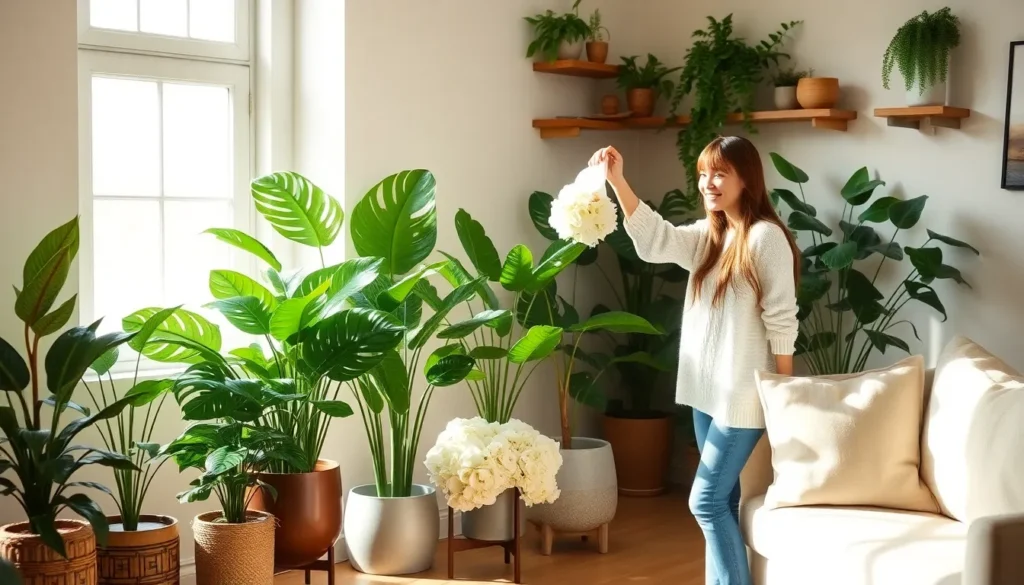We’ve all dreamed of having a lush indoor garden that transforms our living spaces into green sanctuaries. But let’s face it – maintaining real plants can be challenging with busy schedules, limited natural light, or less-than-perfect plant care skills. That’s where artificial plants step in as the perfect solution for modern home decor.
Today’s artificial plants have come a long way from the obviously fake versions of the past. High-quality faux plants now feature realistic textures, natural color variations, and lifelike details that fool even the most discerning eye. We’re seeing homeowners embrace these maintenance-free alternatives that deliver all the visual appeal of real greenery without the watering, pruning, or worry.
Whether you’re decorating a windowless office, a dark hallway, or simply want to add greenery to spaces where real plants struggle to thrive, artificial plants offer endless possibilities. From statement fiddle leaf figs to delicate succulents, we’ll explore how to choose and style these versatile decor elements.
Choose the Right Size and Scale for Your Space
Selecting artificial plants that complement your room’s dimensions creates visual harmony and prevents overwhelming or underwhelming your decor. We’ll explore how to match plant sizes to your exact space for maximum impact.
Consider Room Proportions
Large rooms accommodate bigger artificial plants like 6-foot fiddle leaf figs or towering bird of paradise specimens without appearing cluttered. We recommend choosing plants that occupy roughly 10-15% of your room’s visual space for optimal proportion. Small apartments benefit from compact options such as tabletop succulents, mini snake plants, or delicate ferns that add greenery without consuming precious square footage.
Floor space determines whether you can incorporate statement pieces or should focus on hanging and tabletop varieties. We suggest measuring your available area before shopping to ensure your artificial plants enhance rather than obstruct natural traffic flow. Wide rooms can handle multiple medium-sized plants grouped together, while narrow spaces work best with single vertical specimens or wall-mounted arrangements.
Match Plant Height to Ceiling Height
Standard 8-foot ceilings pair beautifully with 4-6 foot artificial plants that create presence without touching the ceiling. We’ve found that plants reaching approximately 60-75% of your ceiling height achieve the most pleasing proportions. Vaulted or high ceilings above 10 feet can accommodate dramatic 7-8 foot artificial trees like majesty palms or rubber plants that fill vertical space effectively.
Low ceilings under 8 feet require shorter plants ranging from 2-4 feet to maintain proper scale and prevent a cramped feeling. We recommend avoiding tall, narrow plants in rooms with low ceilings as they can make the space feel even more compressed. Instead, opt for bushy, horizontal artificial plants like Boston ferns or wide-spreading philodendrons that expand outward rather than upward.
Balance Multiple Plants Together
Grouping artificial plants in odd numbers creates more natural, visually appealing arrangements than even-numbered clusters. We suggest combining three different heights within each grouping to establish visual rhythm and depth. Mix large floor plants with medium tabletop varieties and small accent pieces to create layered compositions that mimic natural growth patterns.
Spacing between multiple plants should allow each specimen to maintain its distinct shape while contributing to the overall display. We recommend leaving 18-24 inches between larger plants and 6-12 inches between smaller ones to prevent overcrowding. Different textures and leaf shapes within your artificial plant collection add visual interest and prevent monotonous arrangements that lack personality.
Corner arrangements work exceptionally well with graduated heights, placing the tallest artificial plant in the back and shorter ones in front. We’ve discovered that this triangular formation creates depth and draws the eye naturally through the entire grouping while maximizing the impact of each individual plant.
Select High-Quality Realistic Materials
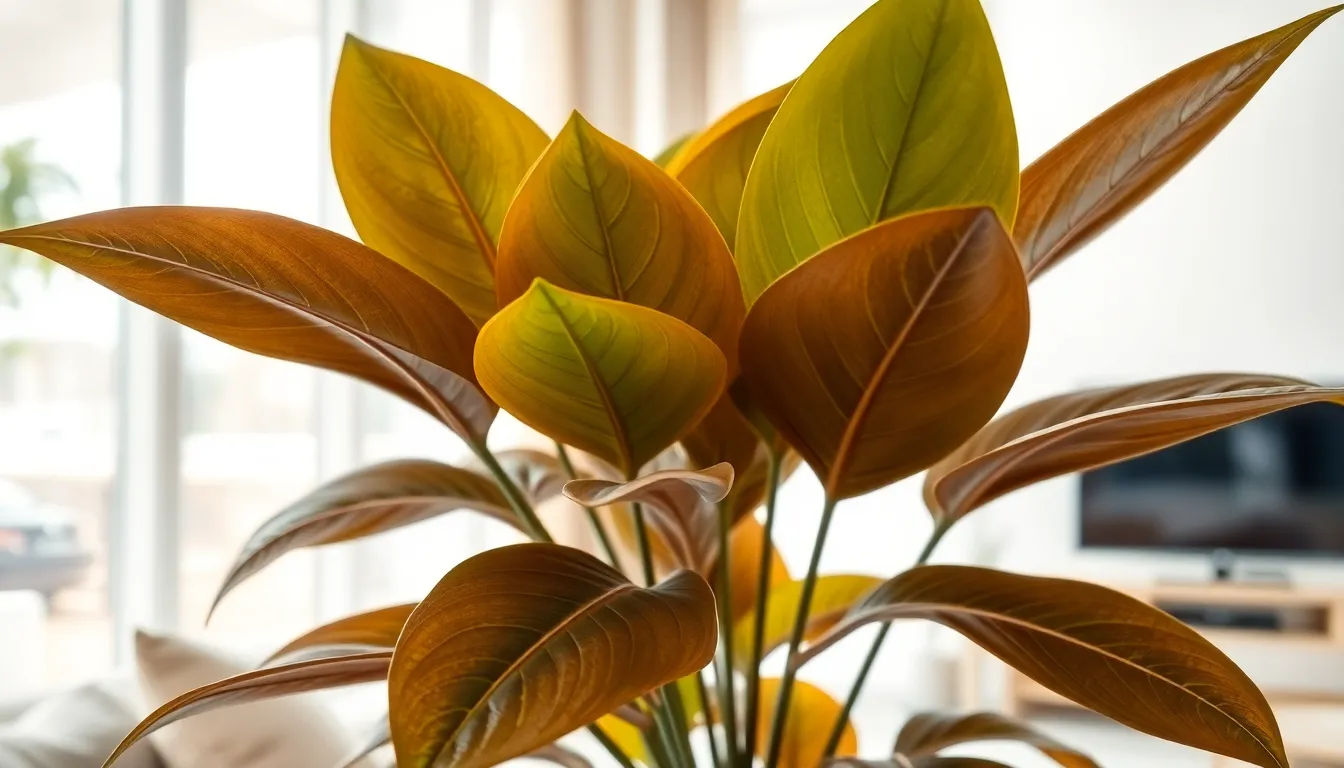
We’ve found that the foundation of convincing artificial plants lies in choosing specimens crafted from premium materials like silk and polyester fabrics. These superior materials create the lifelike appearance that transforms artificial greenery from obvious fakes into stunning decor elements.
Look for Natural Textures and Colors
Subtle color gradations make artificial plants appear authentically alive. We recommend examining each leaf for natural variations in green tones rather than uniform coloring that screams “fake.” Quality artificial plants feature leaves with realistic veining patterns that mimic how light filters through actual foliage.
Texture plays an equally important role in achieving believability. Look for plants with leaves that have embossed surfaces or matte finishes instead of shiny plastic appearances. We’ve noticed that the best artificial plants incorporate multiple shades within single leaves, just like real plants show lighter and darker areas naturally.
Color fidelity should reflect what you’d see in nature. Avoid plants with overly bright or artificial looking greens that don’t exist in real botanical specimens. Quality manufacturers use subtle browns and yellows mixed with greens to replicate the natural aging process of living plants.
Check for UV-Resistant Fabrics
UV resistant treatments prevent artificial plants from fading when placed near windows. We strongly advise confirming this feature if you’re planning to display your plants in bright indoor spaces that receive direct sunlight throughout the day.
Protected fabrics maintain their vibrant appearance year after year. Without UV resistance, artificial plants can develop an obviously faded look that diminishes their realistic appeal within months of sun exposure. Quality manufacturers specifically treat their fabrics to withstand indoor lighting conditions.
Treated materials ensure your investment lasts longer. We’ve seen untreated artificial plants lose their color intensity and develop that telltale washed out appearance that immediately identifies them as artificial rather than living specimens.
Examine Stem and Leaf Details
Realistic stems should mimic the natural woodiness or flexibility of actual plant stems. We look for stems that bend naturally rather than appearing stiff or obviously wire based. Quality artificial plants feature stems with realistic bark textures or natural brown coloring that matches real plant varieties.
Leaf attachment patterns should follow natural growth habits. Examine how leaves connect to branches, ensuring they emerge at realistic angles rather than in obviously artificial straight lines. We’ve found that superior artificial plants have leaves positioned exactly where they’d grow on living specimens.
Construction quality shows in the absence of visible wires or glue marks. Look closely at connection points between stems and leaves to ensure clean, natural looking joins. Quality artificial plants hide their mechanical construction completely, allowing the natural appearance to dominate your visual impression.
Textural details on individual leaves enhance the overall realism. We recommend running your fingers across leaf surfaces to feel for natural textures rather than smooth plastic finishes that immediately identify artificial materials.
Mix Different Plant Types for Visual Interest
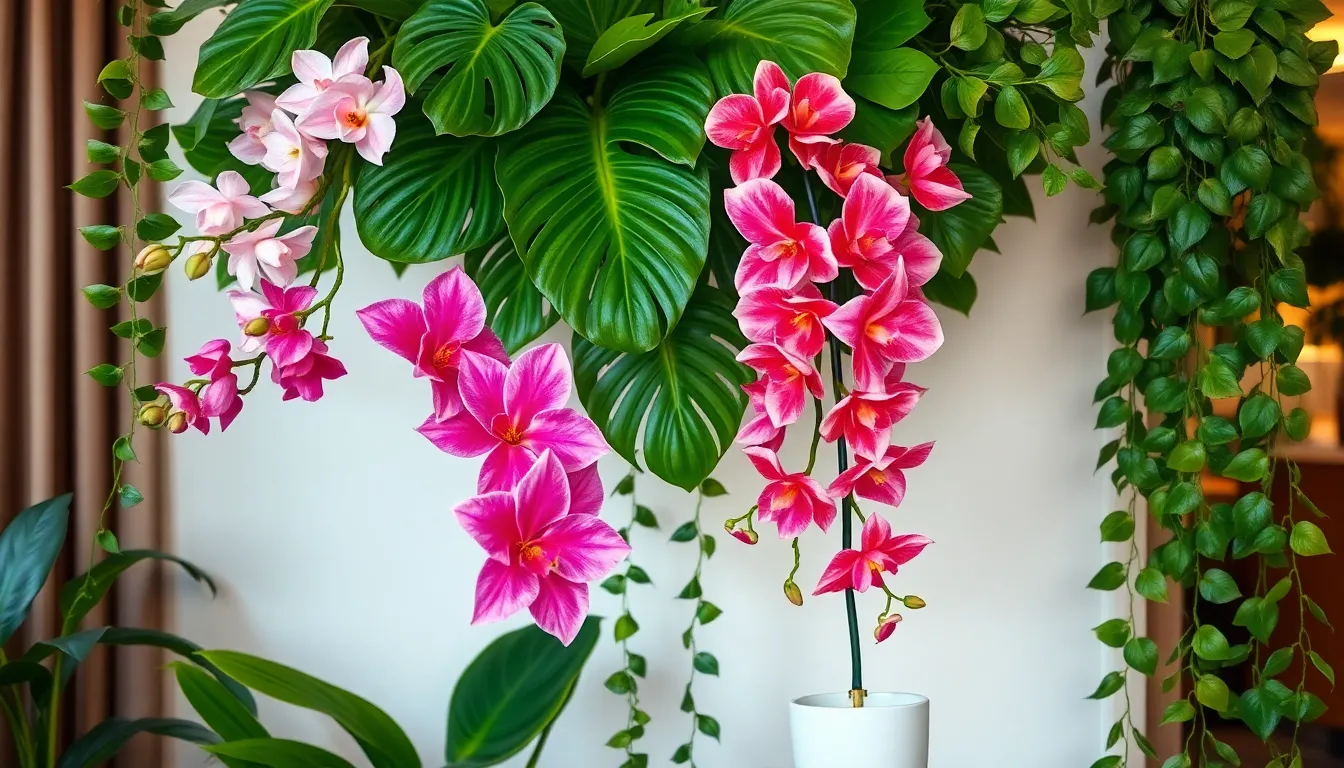
Creating ever-changing visual appeal with artificial plants starts with incorporating variety into your indoor displays. We’ll explore three key strategies that transform ordinary plant arrangements into sophisticated, captivating decor.
Combine Flowering and Foliage Plants
Flowering artificial plants bring vibrant pops of color that instantly brighten any space, while foliage plants provide lush structure and grounding elements. We recommend pairing faux orchids with leafy monstera or ferns to create balanced, lively displays that mimic natural garden settings. This combination prevents visual monotony and adds layers of interest that engage the eye throughout the room.
Contrasting textures between blooms and leaves creates depth that makes arrangements feel more authentic. Flowering plants like artificial roses or peonies serve as focal points, drawing attention with their bold colors and intricate petal details. Meanwhile, foliage varieties like Boston ferns or rubber plants offer subtle backdrop elements that enhance rather than compete with flowering specimens.
Vary Leaf Shapes and Sizes
Different leaf characteristics introduce essential visual texture that prevents arrangements from appearing flat or obviously artificial. We suggest combining broad leaves from fake monstera plants with thin, needle-like foliage from artificial grasses or palm fronds. This contrast creates layered effects that mirror natural ecosystems where diverse plant types grow together.
Size variation adds another dimension to your displays, with large statement leaves providing dramatic impact while smaller, delicate foliage fills gaps and softens harsh edges. Mixing plants with serrated, smooth, pointed, and rounded leaf edges creates organic randomness that sophisticated artificial plant arrangements require. These textural differences catch light differently throughout the day, adding subtle movement and interest to static displays.
Include Different Growth Patterns
Growth habit diversity transforms simple plant groupings into ever-changing, three-dimensional compositions that command attention. We combine upright artificial palms with trailing ivy or cascading pothos to create flowing silhouettes that add movement and natural rhythm to indoor spaces. Bushy plants like artificial ferns provide middle-ground elements that bridge vertical and horizontal elements seamlessly.
Architectural variety through different growth patterns allows you to fill various spatial zones within a room effectively. Tall, columnar plants draw the eye upward and emphasize ceiling height, while spreading or mounding varieties create horizontal interest and ground the arrangement. Trailing plants soften harsh edges of furniture or architectural features, creating gentle transitions between artificial greenery and existing decor elements.
Position Plants in Natural-Looking Arrangements
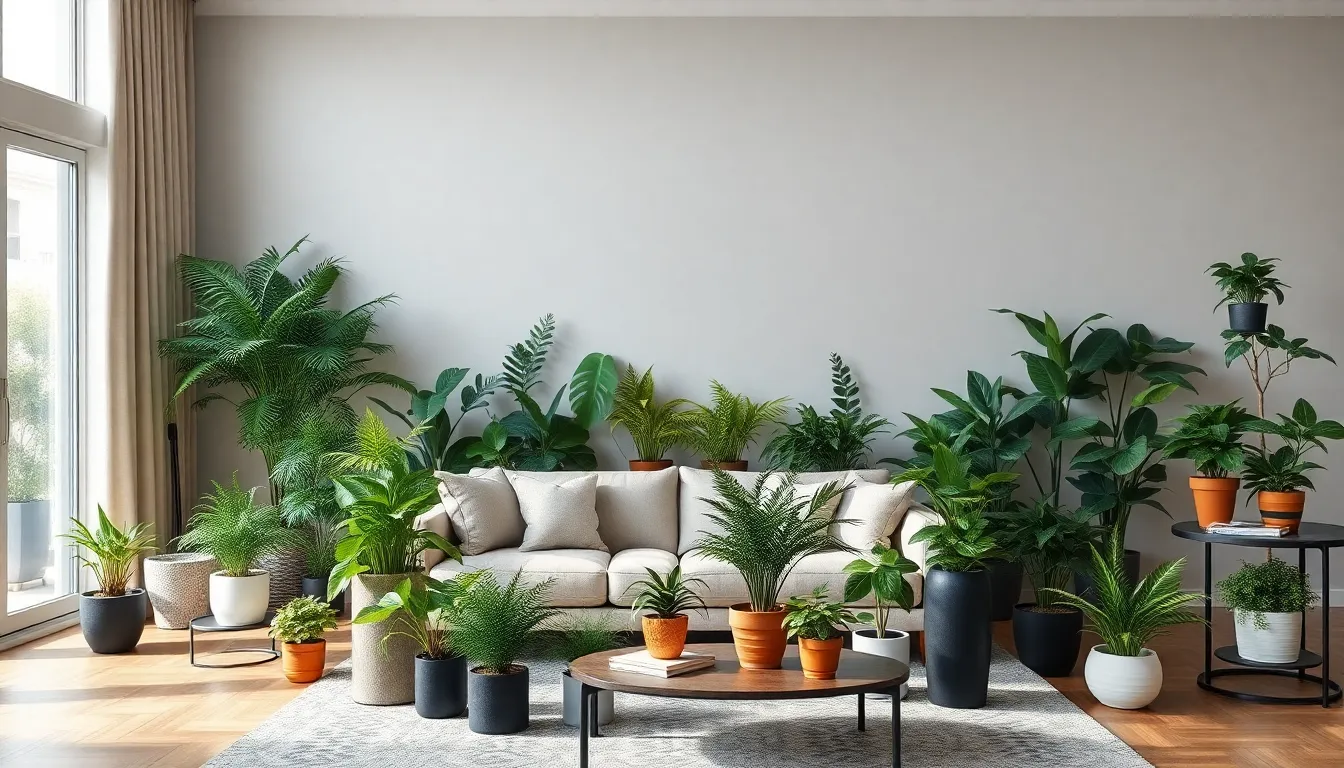
Natural placement transforms artificial plants from obvious fakes into convincing decor elements. We achieve this by mimicking how plants grow in nature rather than forcing them into rigid, unnatural positions.
Follow Real Plant Placement Rules
Positioning artificial plants according to real plant rules creates authentic looking displays. Larger, leafier plants work best on the floor or elevated on plant stands, while smaller specimens shine on tables and shelves. We recommend placing one or two large statement leaves or stems in each vase rather than crowding multiple pieces together, which maintains that classic organic look.
Mixing faux plants with real ones in accessible areas enhances realism significantly. This strategic combination provides flexibility for decor changes while creating a natural balance throughout your space. The real plants add authenticity while the artificial ones fill gaps where live plants might struggle to thrive.
Floor placement works perfectly for larger artificial trees and statement plants. These substantial pieces anchor your room’s design while providing the visual weight that larger spaces need. Elevated surfaces like plant stands add height variation and create natural looking layers in your arrangement.
Use Odd Numbers for Better Composition
Styling with odd numbers creates visually interesting and ever-changing groupings. Three or five plants together form compositions that feel natural and abundant rather than forced or symmetrical. This design principle mimics how plants cluster in nature, where perfect symmetry rarely occurs.
Grouping multiple artificial plants in threes generates lush, layered displays. These arrangements feel more organic because odd numbers create visual tension that draws the eye naturally around the composition. Even numbers tend to split attention equally, creating static displays that lack movement.
Varying heights within your odd numbered groups adds essential visual interest. Combine tall, medium, and short plants within each grouping to create natural looking clusters. This height variation prevents arrangements from appearing flat or artificially uniform.
Create Depth with Layering
Layering plants of different heights and sizes adds crucial dimension to your decor. Placing taller faux trees behind smaller potted plants mimics the natural layering found in outdoor settings. This technique makes artificial greenery appear more realistic and seamlessly integrated into your space.
Background placement of larger plants creates natural depth perception. Positioning substantial pieces like artificial palms or trees against walls provides a backdrop for smaller plants arranged in front. This creates visual layers that guide the eye through your arrangement naturally.
Foreground elements using smaller plants complete the layered effect. Tabletop arrangements and shelf displays work as foreground elements that interact with your larger background pieces. This front to back composition creates the dimensional depth that makes arrangements feel alive and natural.
Incorporate Stylish Planters and Containers
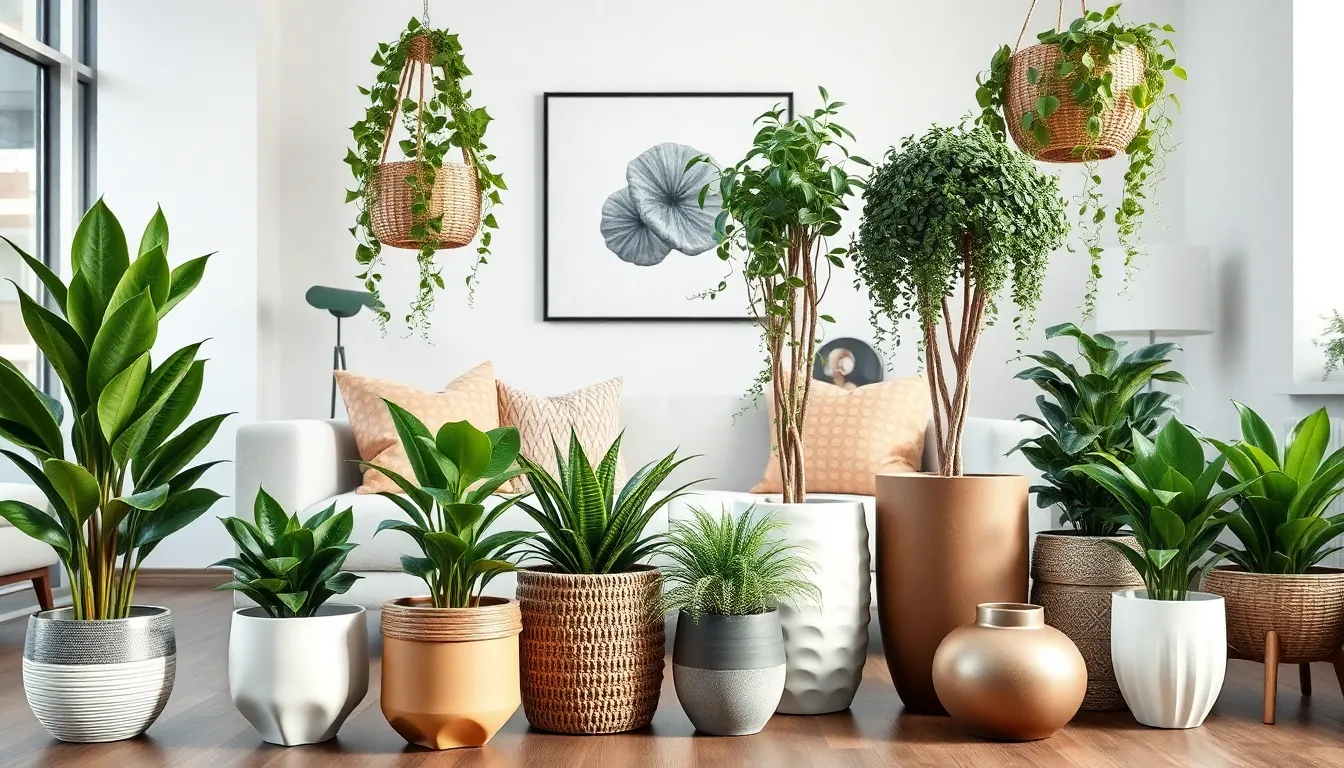
We can elevate our artificial plant displays significantly by choosing attractive planters that complement our indoor decor. Since faux plants don’t require watering or drainage, we have the freedom to select containers purely for their aesthetic appeal and how well they harmonize with our existing design elements.
Match Containers to Your Decor Style
Modern interiors benefit from sleek, minimalist pots that emphasize clean lines and contemporary aesthetics. We recommend ceramic planters with geometric shapes or metallic finishes for spaces featuring modern design elements. Rustic or bohemian rooms pair beautifully with woven baskets or textured containers that add warmth and organic appeal to our artificial plant arrangements.
Classic and transitional styles work wonderfully with ceramic or stone-like materials that provide timeless elegance. We should match our container materials and colors with existing decor to create unified, intentional-looking displays that seamlessly integrate with our room’s overall design scheme.
Choose Appropriate Sizes for Each Plant
Combining various planter sizes creates more natural and ever-changing displays that mimic authentic plant arrangements. We can mix tall floor-standing artificial trees in larger containers with smaller tabletop plants in petite pots for visual balance and interest. Hanging vines paired with upright shrubs in appropriately sized planters add dimensional depth to our artificial plant compositions.
Proper scale ensures each plant looks proportional within its container. We should select bigger pots for larger artificial plants and compact containers for smaller specimens to maintain visual harmony throughout our indoor garden displays.
Consider Drainage-Free Options
Artificial plants eliminate the need for drainage holes, opening up countless decorative container possibilities that wouldn’t work for live plants. We can choose delicate or decorative pots without worrying about water management or potential damage from moisture. This freedom allows us to explore unique materials like metal, glass, or fabric-lined baskets that enhance our decor.
Decorative pot toppers like moss, pebbles, or decorative stones complete the natural look without compromising aesthetics or requiring maintenance. We can layer these elements to create authentic-looking soil surfaces that enhance the overall realism of our artificial plant displays.
Add Complementary Decor Elements
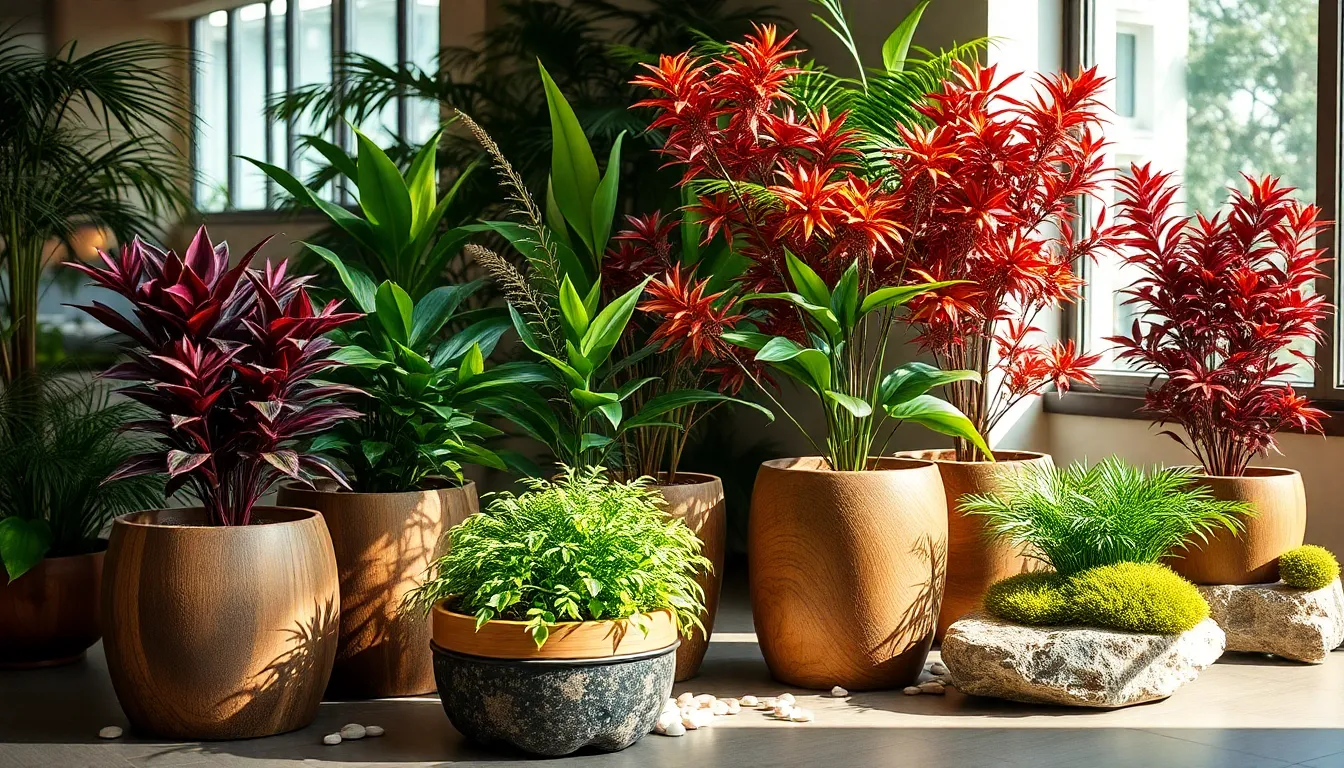
Beyond choosing the perfect artificial plants and stylish containers, we can transform our indoor spaces by incorporating strategic decorative elements that enhance realism and visual appeal.
Include Natural Materials Like Wood and Stone
Natural materials create an authentic foundation that complements artificial plants beautifully. We recommend pairing faux greenery with wooden shelves, which add warmth and texture while providing elevated display surfaces for our plant arrangements. Stone accents and stoneware vases bring earthy elements that naturally harmonize with artificial foliage, creating cohesive indoor garden displays.
Wooden planters offer exceptional versatility for housing artificial plants while maintaining that coveted natural aesthetic. Stone containers provide weight and stability for larger faux specimens, plus they eliminate concerns about water damage since artificial plants require no irrigation. These materials work together to ground our artificial plant displays in organic textures that feel intentional and sophisticated.
Use Decorative Moss or Pebbles
Decorative moss transforms the base of artificial plants into realistic ground cover that mimics natural growing conditions. We place preserved or artificial moss around plant bases to conceal pot edges and create seamless transitions between containers and stems. This simple addition makes artificial plants appear naturally rooted and established.
Pebbles offer another excellent option for improving the authenticity of our faux plant displays. We arrange smooth river rocks or decorative stones around plant bases to simulate natural outdoor environments. Various pebble sizes and colors allow us to customize the look, from zen garden aesthetics with uniform stones to wild garden feels with mixed textures and tones.
Incorporate Ambient Lighting
Strategic lighting elevates artificial plants from simple decor to stunning focal points that command attention. We position soft LED spotlights to highlight the shapes and textures of our faux foliage, creating depth and dimension that makes artificial plants appear more lifelike. These lights cast gentle shadows that add visual interest and prevent flat appearances.
String lights woven through larger artificial plants or plant walls create magical ambiance while emphasizing the greenery’s natural forms. We use warm white LEDs to maintain realistic color rendering that doesn’t distort our artificial plants’ carefully crafted hues. Ambient lighting also extends our enjoyment of indoor plant displays into evening hours, making spaces feel welcoming and alive regardless of natural light availability.
Maintain Your Artificial Plants Properly
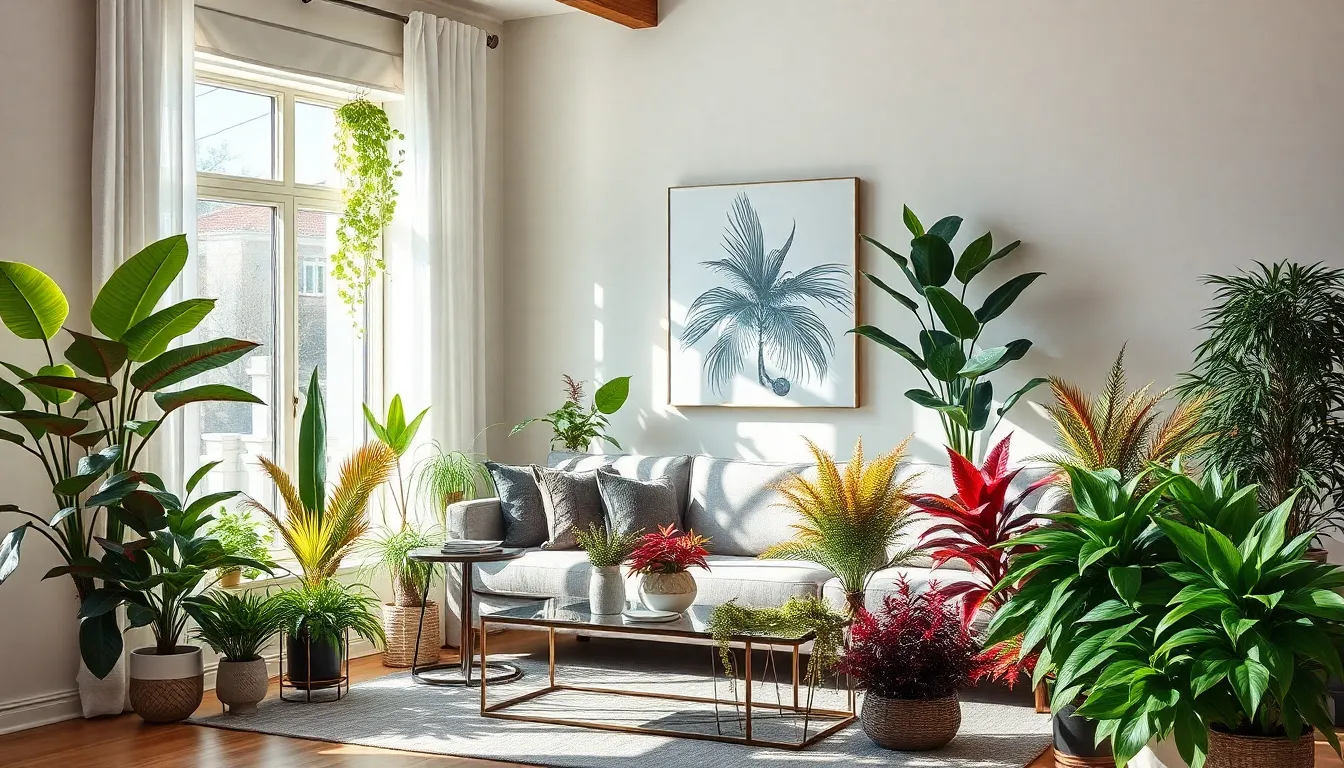
Even the highest quality artificial plants require some basic care to maintain their realistic appearance and extend their lifespan. Following these essential maintenance practices will keep your faux greenery looking fresh and vibrant for years.
Dust Regularly for Realistic Appearance
Dust accumulation is the main factor that reveals an artificial plant’s faux nature and dulls its vibrant colors. We recommend using a clean, soft, dry cloth or feather duster to gently wipe down the leaves, working from top to bottom to ensure all surfaces are covered. Weekly dusting prevents buildup that can make your plants look obviously fake and maintains their natural luster.
Starting with the topmost leaves helps gravity work in your favor as debris falls downward. Microfiber cloths work exceptionally well because they trap dust particles rather than just moving them around. For plants with intricate leaf patterns or delicate textures, soft paintbrushes can reach into crevices where dust tends to collect.
Clean with Appropriate Methods
Deeper cleaning becomes necessary when dust and grime accumulate beyond what dry dusting can handle. We suggest wiping artificial plants with a damp cloth to remove stubborn particles that stick to leaf surfaces. Some artificial plants can tolerate more vigorous cleaning methods, such as rinsing with warm water or using specialized silk flower washes available on the market.
Testing cleaning methods on a hidden leaf first prevents potential damage to visible areas. Gentle dish soap mixed with warm water creates an effective cleaning solution for most artificial plants. After wet cleaning, we recommend allowing plants to air dry completely before returning them to their display positions to prevent water spots or material damage.
Store Seasonal Plants Correctly
Proper storage preserves artificial plants during off seasons and protects your investment. We advise keeping them in a cool, dry place away from direct sunlight and extreme temperature changes to prevent fading or warping over time. Before storage, clean the plants thoroughly to remove dust and debris, ensuring they remain in good condition for future use.
Breathable storage containers work better than plastic bags, which can trap moisture and cause mold or mildew issues. Wrapping delicate leaves in tissue paper prevents crushing and maintains their shape during storage periods. Climate controlled areas like closets or spare bedrooms provide ideal storage conditions compared to basements or attics where temperature fluctuations occur frequently.
Style Plants According to Room Function
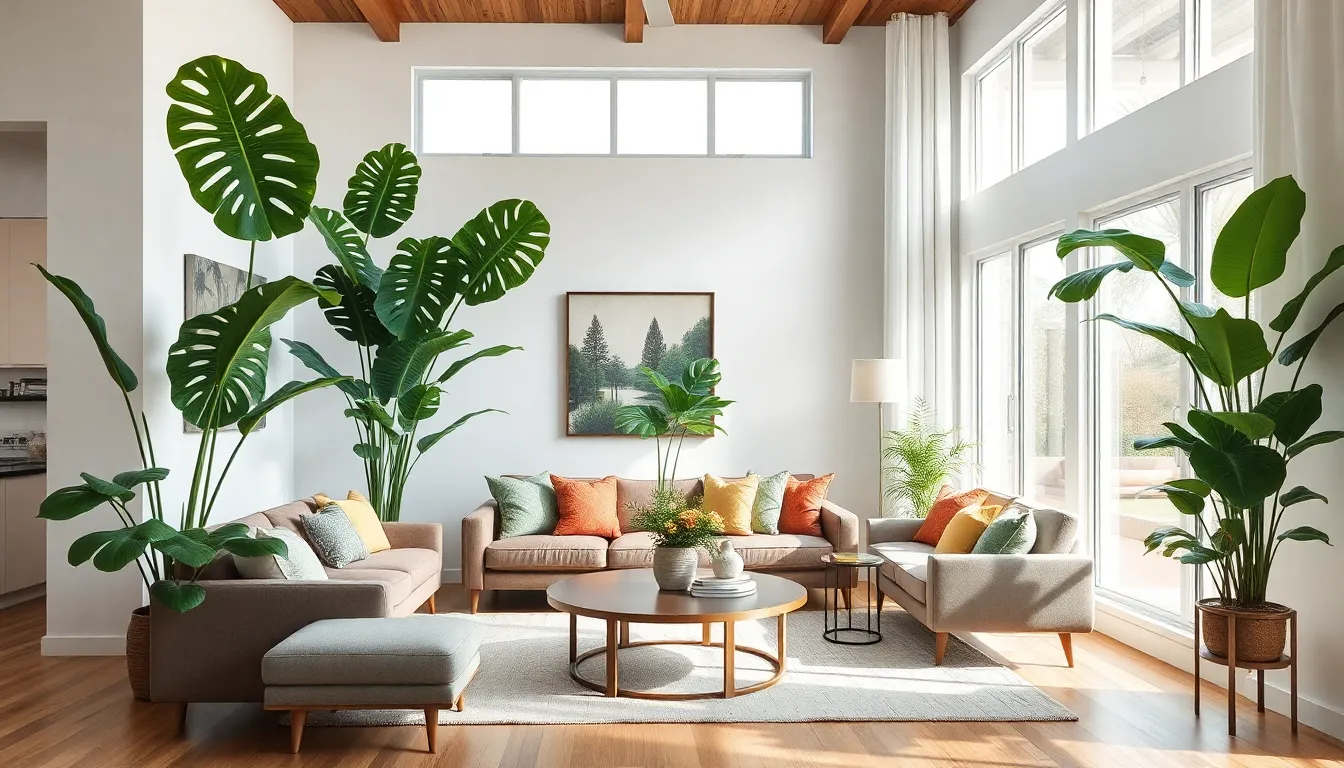
Different rooms serve unique purposes in our homes, and we can maximize artificial plants’ impact by matching them to each space’s exact function and atmosphere.
Living Room Statement Pieces
Bold artificial plants transform our living rooms into stunning focal points that command attention. Large faux fiddle leaf fig trees create dramatic vertical interest while maintaining their perfect appearance year round. Monstera plants add tropical sophistication with their distinctive split leaves, and oversized palm varieties bring resort style elegance to any seating area.
These statement pieces work exceptionally well because they’re completely pet friendly alternatives to toxic real plants. We can position them in high traffic areas without worrying about pet safety or plant damage from curious animals. Their realistic textures and vibrant colors enhance our room’s aesthetic appeal while requiring zero maintenance or natural light.
Strategic placement amplifies their visual impact in our social spaces. Corner positioning creates depth and draws the eye upward, while placing them near seating areas adds natural warmth to conversation zones. The consistent appearance of these artificial specimens ensures our living room always looks polished for entertaining guests.
Bedroom Calming Arrangements
Soothing artificial plants promote restful environments in our most personal spaces. Silk hydrangeas offer gentle, cloud like blooms that create peaceful visual softness, while small faux snake plants provide clean, architectural lines that complement modern bedroom aesthetics. These selections work particularly well in darker bedrooms where real plants would struggle to survive.
Allergy sufferers benefit tremendously from these pollen free alternatives. We can enjoy lush greenery without concerns about seasonal allergies, fragrant flowers disrupting sleep, or airborne irritants affecting our rest quality. The absence of soil and organic matter eliminates potential mold issues that sometimes develop with real houseplants.
Placement considerations maximize their calming influence throughout our bedroom. Bedside tables accommodate smaller specimens that add gentle visual interest without overwhelming intimate spaces. Dresser tops and window sills provide elevated positions that create layered greenery without cluttering floor space or interfering with daily routines.
Office Productivity Boosting Displays
Strategically placed artificial plants reduce workplace stress and improve our visual comfort during long work sessions. Desktop arrangements featuring compact faux succulents or small leafy plants serve as natural mood enhancers that break up the monotony of computer screens and paperwork. Shelf displays create visual breaks that can potentially boost our creativity and focus levels.
These maintenance free options excel in professional environments where real plants often fail. We can enjoy greenery benefits without worrying about watering schedules, adequate lighting, or plant care during business trips and busy periods. Their consistent appearance maintains professional aesthetics regardless of seasonal changes or office climate control.
Research indicates future artificial plants may offer additional functional benefits beyond decoration. Scientists are developing innovative faux plants capable of reducing indoor CO2 levels and generating electricity, suggesting our office greenery could soon provide air purification and energy generation capabilities alongside their current aesthetic and psychological benefits.
Conclusion
We’ve explored how artificial plants can transform any indoor space into a vibrant oasis without the commitment of traditional gardening. From selecting premium materials to creating stunning arrangements these versatile decor elements offer endless possibilities for improving our homes and offices.
The key lies in choosing quality pieces that mirror nature’s beauty and styling them thoughtfully with complementary containers and lighting. Whether we’re dealing with challenging spaces or simply prefer low-maintenance answers artificial plants deliver the lush greenery we crave.
With proper care and strategic placement we can enjoy the psychological benefits of nature indoors while maintaining complete creative control over our environment. The future of artificial plants looks brighter than ever promising even more realistic options for our decorating needs.
Frequently Asked Questions
Are modern artificial plants realistic enough to fool people?
Yes, today’s high-quality artificial plants are incredibly realistic. Premium faux plants made from silk and polyester feature natural textures, subtle color gradations, and realistic veining patterns that can easily deceive the eye. Advanced manufacturing techniques create lifelike stems and leaves that closely mimic real plants.
What are the main benefits of choosing artificial plants over real ones?
Artificial plants offer maintenance-free greenery perfect for busy lifestyles. They thrive in challenging environments like windowless offices and dark hallways where real plants would struggle. They’re also ideal for people with allergies, pet owners concerned about toxic plants, and anyone who travels frequently.
How do I choose the right size artificial plants for my space?
Match plant sizes to your room dimensions and ceiling height. Use larger plants (6-8 feet) for spacious areas and compact options for small apartments. For standard 8-9 foot ceilings, choose plants 4-6 feet tall. In rooms with low ceilings, opt for shorter plants to maintain proper scale.
What should I look for when buying quality artificial plants?
Look for plants made from premium materials like silk and polyester with UV-resistant fabrics to prevent fading. Check for realistic stem details that mimic natural woodiness, natural leaf attachment patterns, and clean joins without visible wires or glue. Quality plants should have varied textures and subtle color variations.
How should I arrange artificial plants for the best visual impact?
Group plants in odd numbers with varying heights to create layered compositions. Mix different types like flowering plants with foliage plants to add color and texture variety. Follow natural placement rules: larger plants on floors, smaller ones on tables and shelves, with proper spacing between each specimen.
Can I mix artificial plants with real plants?
Absolutely! Mixing faux plants with real ones adds realism and balance to your decor. This combination allows you to enjoy the benefits of both – the beauty of living plants where conditions are suitable and the reliability of artificial plants in challenging spots.
What type of containers work best for artificial plants?
Since artificial plants don’t need drainage, you have unlimited container options. Match planters to your decor style – sleek minimalist pots for modern spaces or woven baskets for rustic interiors. Mix various planter sizes and add decorative elements like moss or pebbles for enhanced realism.
How do I maintain artificial plants to keep them looking fresh?
Dust regularly with a soft cloth or feather duster to prevent buildup that dulls colors. For deeper cleaning, use a damp cloth or specialized silk flower wash, testing on hidden leaves first. Store properly in breathable containers, avoiding plastic bags that can trap moisture.
Which rooms work best for artificial plants?
Artificial plants work in every room. Use bold statement pieces like large faux fiddle leaf figs in living rooms, soothing arrangements with silk hydrangeas in bedrooms, and strategically placed plants in offices to reduce stress and enhance productivity without maintenance concerns.
Do artificial plants provide any psychological benefits?
Yes, artificial plants offer similar psychological benefits to real plants, including stress reduction and improved mood. They provide visual breaks in work environments, create calming atmospheres in bedrooms, and help people with allergies enjoy greenery without health concerns.

